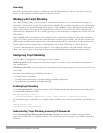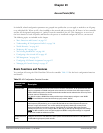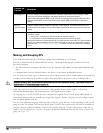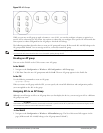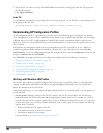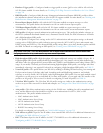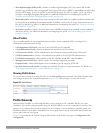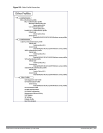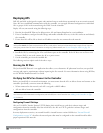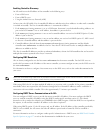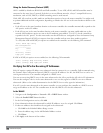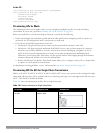
400 | AccessPoints(APs) DellPowerConnectW-SeriesArubaOS6.2 | User Guide
admission controls, and sets limits for the numbers of simultaneous Session Initiated Protocol (SIP), SpectraLink
Voice Priority (SVP), Cisco Skinny Client Control Protocol (SCCP), Vocera or New Office Environment (NOE)
calls that can be handled by a single radio. For additional information on configuring this profile, see "Scanning
for VoIP-Aware ARM " on page 704.
l Traffic management profile—Specifies the minimum percentage of available bandwidth to be allocated to a
specific Virtual AP when there is congestion on the wireless network, and sets the interval between bandwidth
usage reports. For additional information on configuring this profile, see Table 98.
l WMM Traffic management profile—The profile for Wi-Fi Multi-Media (WMM) traffic management prioritizes
voice and video traffic above other data traffic . For additional information on configuring this profile, see "Voice
and Video" on page 682.
Working with RF Management Profiles
The profiles configure radio tuning and calibration, AP load balancing, and RSSI metrics.
l 802.11a radio profile—Defines AP radio settings for the 5 GHz frequency band, including the Adaptive Radio
Management (ARM) profile and the high-throughput (802.11n) radio profile. For additional information on
configuring this profile, see "802.11a and 802.11g RF Management Profiles" on page 424.
l 802.11g radio profile—Defines AP radio settings for the 2.4 GHz frequency band, including the Adaptive Radio
Management (ARM) profile and the high-throughput (802.11n) radio profile. Each 802.11a and 802.11b radio
profile includes a reference to an Adaptive Radio Management (ARM) profile.
If you want the ARM feature to dynamically select the best channel and transmission power for the radio, verify
that the 802.11a/802.11g radio profile references an active and enabled ARM profile. If you want to manually
select a channel for each AP group, create separate 802.11a and 802.11g profiles for each AP group and assign a
different transmission channel for each profile. For additional information on configuring this profile, see
"802.11a and 802.11g RF Management Profiles" on page 424.
l ARM profile—Defines the Adaptive Radio Management (ARM) settings for scanning, acceptable coverage levels,
transmission power and noise thresholds. In most network environments, ARM does not need any adjustments
from its factory-configured settings. However, if you are using VoIP or have unusually high security requirements
you may want to manually adjust the ARM thresholds. For complete details on Adaptive Radio Management,
refer to Adaptive Radio Management (ARM) on page 346.
l High-throughput radio profile—Manages high-throughput (802.11n) radio settings for 802.11n-capable APs. A
high-throughput profile determines 40 Mhz tolerance settings, and controls whether or not the APs using this
profile will advertise intolerance of 40 MHz operation. (This option is disabled by default, allowing 40 MHz
operation.) For additional information on configuring this profile, see "Configuring a High-Throughput Virtual
AP" on page 340.
l RF optimization profile—Enables or disables load balancing based on a user-defined number of clients or degree
of AP utilization on an AP. Use this profile to detect coverage holes, radio interference and STA association
failures and configure Received signal strength indication (RSSI) metrics.
l RF event thresholds profile—Defines error event conditions, based on a customizable percentage of low-speed
frames, non-unicast frames, or fragmented, retry or error frames. For additional information on configuring this
profile, see "RF Event Configuration" on page 433.
l Spectrum Profile—Defines the ageout times for devices seen by a spectrum monitor. For more information
about the spectrum profile default settings, see "Understanding Device Ageout Times" on page 613.
Provisioning Mesh Profiles
You can provision Dell APs to operate as mesh points, mesh portals or remote mesh portals. The secure enterprise
mesh environment routes network traffic between APs over wireless hops to join multiple Ethernet LANs or to
extend wireless coverage. The Mesh profiles are:



